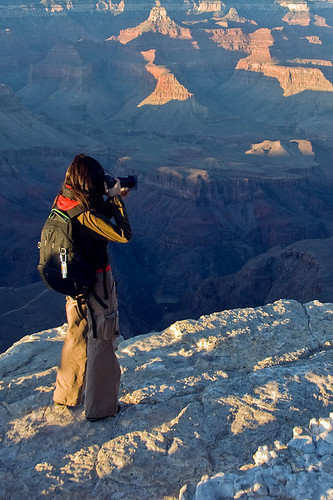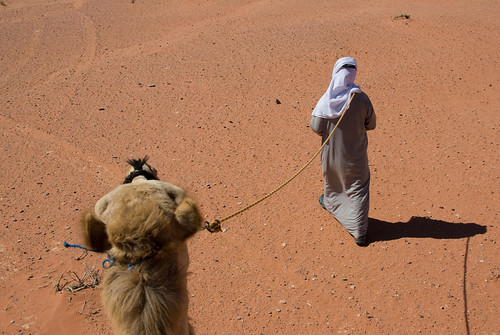Timothy Ferriss's Blog, page 126
November 25, 2010
Wife-Hunting: How to Marry a Brazilian Model

Photo: Jeremiah Thompson
Before hiring one of my assistants, Charlie, I asked him where he wanted to be in 6 and 12 months.
I made him define what he wanted to have and what he wanted to do in both timeframes. At the top of the list was a mini-retirement to Thailand or South America.
Done and done.
Charlie just returned three weeks ago from Buenos Aires. It was there he developed a rather keen interest in Brazilian girls, who were visiting Argentina as tourists. Two weeks ago at around 2am, while preparing the new book launch at my house, he somehow accidentally (riiiiight) got stuck in a Flickr slideshow of Brazilian models.
The photos belonged to someone named Jeremiah Thompson.
Digging a little deeper, it turned out that Jeremiah had an incredible story. Two years ago, he decided he wanted to become a professional photographer of Brazilian bikini models. That, and he wanted to get married. Despite the fact that he was from Montana and had no training, he made both happen in record time.
This is his wife-hunting story…
An Interview with Jeremiah Thompson
What's your background?
I was born in Missoula, Montana, a small college town in the heart of the Rocky Mountains. My Dad was a colonel in the Army so I grew up all over the place, including a couple of stints in Germany. I definitely have a strong entrepreneurial background and have been in business in one form or another all my life, starting at a very young age. The internet has helped me open up .
Did you have much experience as a photographer?
If I thought I could make it rich taking photos, I would have gone into this profession a long time ago. But really, photography has always just been a hobby.
How did you choose Brazil as your destination?
Learning how to surf was, believe it or not, a real stepping stone in my life. About four years ago, I learned how to surf behind an artificial wave put up by a wakeboarding boat. I really got into the sport and wanted to carry my surfing aspirations into the ocean. I narrowed my choices down to Australia and Brazil. A 15-minute phone call to Hans Keeling of Nexus Surf convinced me that Florianopolis, Brazil would be the perfect place for me to go.
[Editor: Some of you might recall that Hans, a recovered ex-lawyer, is a case study in The 4-Hour Workweek]
How did the calendar idea come about?
Arriving in Florianopolis in January of 2008, I was amazed by the sheer quantity of beautiful women — they were everywhere! I'd always had this dream of photographing models, so it was a perfect opportunity to make that dream come true. I coined the calendar name "Girls of Brazil" and so the adventure began. Then I just needed to find the models.

Photo: Jeremiah Thompson
So, how and where did you find the models?
The first model really set everything into motion.
I was hanging out with Hans Keeling (the owner of Nexus Surf) at Praia Mole Beach, when we passed a super sexy woman working at a fresco paddle rental stand. I had already mentioned my swimsuit calendar idea to Hans, and he happens to speak perfect Portuguese. I asked him if he would help me talk to her and pitch the idea. At this point, I had no product or business cards — just a pair of board shorts, my camera, and some photos of wildlife I had taken in Montana. But that was all I needed. It worked. She agreed to meet me the next day! She was even going to hitchhike to my house at 5:00 AM! I convinced her to let me pick her up, and we shot the next day from 5:30 AM till 8:30 PM. It was a great start to my project.

Photo: Jeremiah Thompson
After that, I found most of the girls on my own, speaking to them in very basic (if not completely broken) Portuguese. I was able to find girls almost everywhere – at the beaches, clubs, supermarkets, walking down the street, and even online. It was too easy. Once I had a few great shots under my belt, I was able to show these same photos to other girls, and most wanted to participate just to get their own pictures taken.
Where they professional models?
The girls were, for the most part, your everyday gals. I did shoot one girl who was actually an international model. I found her while I was driving down the street. I jumped out of my car, chased after her, and asked if she wanted to participate. You would think someone like that would laugh at me, but she ended up making the photos:

Photo: Jeremiah Thompson
Quite a few of the models had experience as event girls. I had the best luck finding those girls online.
But my best photos came from the girls with no professional experience. They always came to the shoots with the most energy. Their openness allowed me more freedom to infuse my own ideas into the photo shoot. This definitely made things more fun, and the results were always great.
Did you have to pay them for the shoots?
During the first year, I never paid any of the models. By the second year, I started paying a little. I had been dating one of the models and she helped me realize that many of the girls were actually using their own money just to prepare for the photos. They were paying to get their hair done, manicures/pedicures, new bikinis, etc. It was expensive. I started paying them 500 Brazilian reais, which amounted to approximately $250 US dollars. And because I shot many of the girls multiple times, it was a very small price to pay. However, I'm convinced that even if I didn't pay anything, I would have just as much success or possibly even more. The girls, especially in the first year, really got excited about the opportunity, even though there was no money involved.
Critics might say you were taking advantage of them. What would you say to that?
One of the cool things about this project is the success they've had using my photos afterward.
Four of the girls went on to pose for Playboy Brasil. One of the girls got hired on as a dancer for the top television show in Brazil on Sunday afternoons. Many got modeling jobs. And they've all appreciated the opportunity, so that's one of the best things about doing this.

Photo: Jeremiah Thompson
For those who've dreamed about being a swimsuit photographer but have never had the chance, can you describe the atmosphere of a shoot?
The atmosphere is definitely one of the best things. It starts when the girls come to my house. I need to see them in their bikinis before we head out so I can prepare for the shoot. In the first year, all of the girls used their own bikinis and that worked great 90% of the time. But I started buying bikinis for the girls in year two. So the first step was always to pick out the best bikinis. We would usually find 2-4 bikinis that we would take to the shoot. After that, we either walked to a nearby local beach or took my car to a more private beach.
Usually, we would arrive before sunrise. This meant the girls had been up since 2:30 AM preparing! I typically rolled out of bed around 5:00 AM. Not an easy thing to do, but when the moment comes and those first rays of light hit a beautiful girl in a tiny bikini, it's worth it.

Photo: Jeremiah Thompson
Posing the girls was always the most difficult part. I wanted to bring out the best in each girl. I would put them through as many poses as possible, mentally noting how they looked best. Then when the best lighting conditions occurred, I would get the girls into what I already knew would be their best pose. This system worked great.
After the shoots, the first question from the girls was always: "When will the photos be ready?"
Sometimes, if I enjoyed the shoot, I would invite the girl back to my house so we could look at the photos together on my computer. Otherwise, I took a few days to do some basic edits, then we'd meet up and I'd give them the best photos.
Were there any methods you used to produce better results (i.e. humor to loosen up the model, etc.)?
I enjoyed bringing out the genuine smiles of each girl.
Most model photos always have that super serious look, which is supposed to be sexy. I don't know if I'm different in this regard, but I always enjoy seeing a girl's smile more. So for half the photos, I would get the girls smiling their biggest smiles possible, and the other half I would let them revert to that serious but "sexy" look you see in all the magazines. Getting the girls to smile was easy: I would just say "mais sexo!" For two years I thought that phrase meant "sexier!" but I guess it really means "more sex!" So it usually made the girls laugh before going into an even sexier pose. That's how I discovered the girls' natural smile and how great it looked in the photos.

Photo: Jeremiah Thompson
What have been some of the more memorable moments from your shoots?
I've shot something like 30-40 girls now, and there are so many memories with each girl.
Fernanda was my first model and she will always be one of the best memories of this project. Actually, the first photo I took of her is, to this day, one of the best I have ever taken:

Photo: Jeremiah Thompson
Then there was Iris, who showed up an hour and a half late to our shoot. We jumped in my car and she changed into her bikini as I sped off. When we arrived at the beach, I quickly put her into a pose, and we made this photo [below] in about 10 minutes. It was not a minute too soon, as the sun set right after.

Photo: Jeremiah Thompson
When I think about how much preparation goes into a Sports Illustrated shoot and compare it to some of the photos I've taken, I'm amazed by the results I've had as a one-man operation. It really is a credit to the beauty of these girls and the environment I am working with down in Brazil.
Last but not least, there's Dayana.
She and I ended up getting married, so how could I not mention this as one of my best memories?! We were really connected right from the beginning. It was a goal of mine to find a woman like Dayana to marry, so having this dream come true as a result of this project was incredible, to say the least.

Photo: Jeremiah Thompson

Photo: Jeremiah Thompson
What sales channels have you used for distribution of the calendar?
I've never had the opportunity of getting into the main calendar distribution channels, due to my lateness of releasing the calendars. I learned afterward that most calendars get released almost a year before the calendar year.
That meant the calendar had been shot as early as two years before. Since I was doing this more for fun than to make money, I decided to release the calendars as close to the calendar year as possible. The models were happy with this, as they didn't have to wait two years to see their photos debut. It wasn't smart business on my part, but again, I wasn't doing the project to make the most money.
Having said that, we've enjoyed being one of the top calendars through Amazon for a couple of years now. We're giving "Sports Illustrated" a run for their money (at least with Amazon) and I feel a great amount of pride seeing that and knowing how small my operation is compared to them.
Have you done any unique promotions to get the word out?
In 2009, we sent 20,000 calendars to troops in Iraq and Afghanistan. In 2010, we sent approximately 3,000 (I was working with a bigger personal budget in 2009 than in 2010). I hope to get these numbers back up in future years if I stay involved in the project. I always get troop requests and have a list of soldiers who have already requested their copies for 2011. It feels great helping these guys out. Hopefully seeing the beautiful girls on their walls keeps them motivated to stay strong and finish out their missions safe.


What's the "Girls of Brazil" contest you mentioned to me?
The idea behind the contest is to give someone the chance to live the dream of being a swimsuit photographer. There really is no better place than Brazil for this.
I'd help the lucky winner of this contest along with each step. First, we'll recruit the girls and find the models he'll be shooting. Then I'll give him my camera equipment and teach him how to photograph the girls. The winner will be shooting the girls on his own, but I'll be around if he needs my help. And afterward, we'll celebrate the results "Brazilian style"!
The contest doesn't exist yet, but I'm hoping to get sponsored by a magazine who can feature it. It would make a great story and fill several issues of their magazine with content guys will love.
That sounds like a once-in-a-lifetime experience. If a magazine doesn't pick up the contest, perhaps we can make it happen :)
—
So, how did his calendars turn out? Take a look at Girls of Brazil website or visit Amazon. If you want a taste of his photos on Facebook, here's your fix.
Question of the Day (QOD): If you're happily married, how did you meet your husband or wife, and do you think someone could engineer the same? Share in the comments!
###
Odds and Ends: Blogging Lessons and New Stickers
Blog Lesson 1 – Please Everyone to Interest No One
If this post put your knickers in a twist, before leaving a snarky comment, realize this: when everyone is your customer, no one is your customer. This is true in business and writing. Bloggers often make the mistake of trying to generalize every post to every person. This is slow suicide and results in plain vanilla posts that offend no one and interest roughly the same. Expect that blog to disappear within two years, whether from reader attrition or blogger boredom.
I prefer to write posts that strongly appeal to at least a portion of my readers, and simply rotate to hit different demographics/psychographics with different posts. If I perfectly hit the nail on the head by educating (or entertaining) 20% of my readership, and they share it with their friends, does it matter if I lose 2-5%? Not in my experience. From what I've seen, this is precisely how you build an uberstrong community comprised of readers who actually speak their minds and show an unusual degree of tolerance (by Internet standards, at least).
If you'd like to read the female perspective on the mating and marrying game, here's another post on this very same blog.
Blog Lesson 2- Strategic Redating of Posts
Some of you have asked, where did the last two posts go? The posts on GetGlue stickers and book promotion parties?
Here's the answer: I redated them in WordPress so they wouldn't appear on the homepage. Once time-dependent promotional posts have been up for 48-72 hours, and my core audience has seen them, I redate them, as these posts aren't valuable to new visitors. There's only one chance to make a first impression, so I always want strong stand-alone content to dominate my blog homepage. I'd used redating in this fashion for more than two years. Some bloggers go so far as to ensure one of their most popular posts is always displayed first on the homepage, followed then by their most recent.
Hope that explains things.
Eat drink and be merry. Happy Thanksgiving!
New Stickers – The 4-Hour Body
The 4-Hour Body is almost exactly three weeks away, which means a new sticker from GetGlue! This one is of reader, Nathan. To learn how to get it (and all the others) for free, read this:
[image error]
November 21, 2010
How It Works: Clinton's "Reality Distortion Field" Charisma

One piece of the puzzle: getting eye contact right. Not evasive, not creepy — just right. (Photo: Mr. Theklan)
This is a guest post from Michael Ellsberg, a good friend who's spent the last several years studying interpersonal persuasion and language (spoken and unspoken).
He has performed hundreds of tests in the field, as the creator of Eye Gazing Parties, which resembles speed-dating with no speaking. Elle magazine called his parties "New York's hottest dating trend," and for good reason. Having attended one party, I can attest: three minutes of staring into someone's eyes tells you more about them than ten minutes of talking.
In this post, he deconstructs Bill Clinton's so-called "reality distortion field" into elements you can practice for business or pleasure. Don't miss the play-by-play video demonstration…
Enter Michael Ellsberg
I've figured out the secret—or at least, a big secret—of Bill Clinton's legendary charm and face-to-face persuasion.
"I have a friend who has always despised Bill Clinton," a person at a cocktail party told me during the time I was writing my book about eye contact. "Yet, somehow my friend found himself at a function that Bill Clinton was attending. And, within the swirl of the crowd, he was introduced to Clinton."
"In that moment, face-to-face, all of my friend's personal animosity towards Clinton disappeared, in one instant," my new acquaintance at the party continued. "As they were shaking hands, Clinton made eye contact with my friend in a way so powerful and intimate, my friend felt as though the two of them were the only people in the room."
Steve Jobs is famous for having a "Reality Distortion Field" (RDF)—an aura of charisma, confidence, and persuasion, in which people report it almost impossible to avoid surrendering to the man and following his will when interacting face-to-face. Well—love his politics or hate them—Clinton is known for an RDF even stronger than Jobs'. Perhaps the strongest in the world.
So, what's the secret to Clinton's RDF?
While writing my book, I heard some version of the above story about Clinton not once but three times. So, I Googled "Bill Clinton" and "eye contact." A number of references to Clinton's eye powers turned up.
A New York Times Magazine profile near the beginning of his presidency referred to his facility for "making eye contact so deep that recipients sometimes seem mesmerized. Tabloid rumors aside, Clinton embodies the parallels between the seductions of politics and the seductions of sex. As one Clinton watcher said recently: 'It's not that Clinton seduces women. It's that he seduces everyone.'"
A post on the celebrity news blog WENN said, "Actress Gillian Anderson has discovered the secret behind former U.S. President Bill Clinton's sex appeal—lingering eye contact."
Anderson (Special Agent Dana Scully on The X-Files) spoke on Late Night With David Letterman of an encounter she had with Clinton several years earlier: "We all, mostly women, lined up. And when he gets to you, he takes your hand and makes eye contact. After he leaves and he moves on to the next person, he looks back at you and seals the deal. When I got home, I expected to have a message from him, and I didn't. I bet women across America expect it too."
Is it possible to hack this skill with eye contact? Is it possible to recreate Bill Clinton's fabled RDF? (At least, the eye contact part?)
Absolutely. In my experience training myself and others, you can become a world-class master of eye contact in about 2 weeks.
How to Go From "Eye Shy" to "Eye Ballsy" In Three Easy Steps
STEP 1: Practice Brief Eye Contact With Strangers
While you walk down the sidewalk (during daylight hours!) look at the eyes of every person walking towards you long enough to see their eye color. Less than a second. Then look away. This is the best technique I know for building solid eye contact skills quickly. In my experience, if the eye contact is brief enough, no one minds at all, and you get tons of practice in.
You can also practice longer eye contact with waiters, salesclerks, cashiers, and other paid service staff, so long as you do it respectfully and in a friendly way.
In all cases, keep a neutral facial expression and soft gaze. You don't want anyone to think you're trying to stare them down, rob them, or get them into the sack. If you practice all this for a week or two as you go about your daily business, the quality of your eye contact will become better than most people's, in a short amount of time.
STEP 2: Learn the Art of Personal Space
You've probably experienced bosses or strangers "get up in your face," and it feels very unpleasant. Bill Clinton and others with RDFs are experts at getting close to you while making you feel totally safe and comfortable. This increases feelings of intimacy, trust, and affinity.
How do they do it? They have mastered the subtle art of personal space. First written about in-depth by anthropologist Edward Hall, our sense of "personal space" is the feeling we get of being "invaded" when someone steps too close.
Interestingly, our sense of personal space is not a pure function of physical proximity; many other psychological factors influence it. In general, your sense of physical proximity with someone increases when they are:
- Making direct eye contact with you
- Facing you directly (as opposed to standing side-by-side looking into the crowd)
- Touching you (i.e., rubbing elbows in a crowd, patting your back, touching your arm or shoulder)
- Raising their voice
- Talking about you (as opposed to a neutral subject)
If a stranger starts doing too many of these at once, your personal space begins to feel violated, and you start having that icky "eww get away from me!" feeling we've all experienced with unwelcome conversations at parties.
In contrast, if you learn to modulate these five different factors, and combine them in different ways, you can make your conversation partners feel safe and comfortable while at the same time feeling close and intimate with you.
When you increase eye contact, try leaning back or standing back a little to increase their comfort. When you are physically close because it's a crowded room, try lowering your voice. When you pat someone on the back or touch their arm as you talk, try standing at an angle, not facing them directly.
By playing with these different factors, cranking some of the dials up as you turn others down, you can create the feeling of being incredibly close, without triggering the "Red Alert! Get Away!" response in your conversation partner. People with RDFs are masters of this skill. And it's very seductive.
STEP 3: Practice Being Present
Have you ever felt someone was making eye contact with you, but wasn't taking in a thing you were saying? My friend Marie Forleo has referred to this phenomenon as a "pretend gaze—their eyes are on yours, but their mind is on a Hawaiian beach."
In our age of tweets and Facebook status updates and cellphone buzzes and new texts and IMs and VMs every few seconds, focusing your inner attention on the same person you're talking with can be challenging, but its worth practicing the skill. (BTW, following Tim's low-information diet helps with this.)
For one week, whenever you talk with someone, practice noticing whenever your mind drifting—to the laundry, your bills, you co-worker's snide comment today, that hottie you just spotted at the party whom you want to meet. Then, when you notice this inevitable mental drifting, bring your attention back to whomever you're talking with at the moment. They will truly appreciate it.
We are living in a world where no one, it seems, has attention for anyone or anything for more than a few moments. How rare it is when someone pays attention to us. Consider the wording of the phrase: pay attention. In industrialized nations, at least, attention is becoming almost as scarce a resource as money. Someone who "pays" it to you is giving you something of true value.
As Elizabethan poet and statesman Fulke Greville has written, "Our companions please us less from the charms we find in their conversation than from those they find in ours."
Clinton pays out his focused attention generously, making us feel he's truly interested in us and what we have to say. This is why people love talking with him face-to-face.
That feeling of "we were the only two people in the room," which Clinton is so skillful in fostering, stems from his eye contact, from his careful use of personal space, and from his unshakeable attention once he's talking with you.
Learn to combine these three factors together, and you're on your way to a rock-star Reality Distortion Field. Just be careful about what you do with all the attention!
BONUS: If you want a fantastic education in how the three factors we've been talking about–eye contact, personal space, and presence–interplay to create legendary persuasion, watch the below video clip from the second Bush-Clinton-Perot debate, on October 15, 1992.
The idea of a town-hall format was proposed to the Bush team by Clinton's team in 1992, and Bush agreed. This was the first town hall presidential debate in US television history. Little did Bush know he had just agreed to battling the master on his own territory.
To appreciate just how fully Clinton nails this debate moment, I suggest watching the 4-minute clip twice–first with audio turned off, and then with audio on. If you're at all interested in this post's topic, it'll be worth it.
I'll put several comments below the video. [Note: I am not making any endorsement one way or the other about the political views expressed in this clip. I'm only talking about body language and persuasion.]
Commentary:
First point: In the initial seconds of the video, Bush checks his watch when the voter begins asking him a question. Presence? How about "How long do I have to listen to you before I can talk?" This was widely considered a "Dukakis-in-the-tank/Dean Scream" moment during the campaign, and among the worst gaffes in presidential debate history (up there with Gore's sighs and eye rolls in 2000). And it all hinged on one moment of absent presence.
Notice Bush's eye contact as he answers the woman's question. It is sporadic, weak, drifting, and random. He hasn't decided whether he's talking to her, to the moderator, to the whole audience, or to the air in the room. In terms of personal space, he is totally unsure of how close he should stand; he walks closer to her, then backs off, visibly uncomfortable with the personal space aspect of the interchange. In all three factors of RDF we've talked about–eye contact, personal space, and presence–he's clearly not making a personal connection with the voter.
At 2:30, when Clinton begins to answer, notice how he manages to simultaneously own the space and put the woman at ease. He walks up several yards closer than Bush did, making a personal connection in her space, without making her uncomfortable. His eye contact is clear, unwavering, and calm. There's absolutely no mistaking whom he's talking with. Clinton's there in the room with two rival candidates, news media, other audience members, and a national TV audience of millions. Yet that feeling of "The only two people in the room" is palpable when he talks with the voter.
The result of this town hall debate? 58% of viewers declared Clinton the winner of the debate, 16% for Bush, and 15% for Perot. (In the previous debate, with a traditional podium format, 47% of viewers declared Perot to be the winner, with 30% for Clinton, and 16% for Bush.)
Look at the woman's response at 3:22. Clinton completely has her. (Remember actress Gillian Anderson's comment?) Bush's facial expression at 3:47 is priceless. He knows he's been beaten.
###
About the author: Michael Ellsberg is the author of The Power of Eye Contact. For his forthcoming book, already purchased by Penguin/Portfolio, he's seeking to interview people who didn't finish college who are successful at what they do. Fit the bill? Go to this page.
Ellsberg is also the creator of Eye Gazing Parties, a series of social events based on eye contact which attracted feature press coverage from the New York Times, Associated Press TV, CBS News, CNN, Good Morning America, MSNBC, Regis & Kelly, and more. Elle magazine called Eye Gazing Parties "New York's hottest dating trend."







November 17, 2010
4-Hour Body Promo – Half-Naked Girls, Erections, and Stickers
On this blog, I try and strike a balance — well, it's more like a ratio — of 80% useful content and 20% fun for sh#$% and giggles.
If the blog isn't fun for me to write, it will end up boring to read, so I sometimes visit Random Land. This is such a time. I think athletic girls are fantastic (don't worry, ladies — goodies for you soon), and I like stickers. So what do you get?

The 4-Hour Body promotional stickers!
The 4-Hour Body is almost exactly 4 weeks away, and each week, I will be debuting a new countdown sticker, ending with a launch sticker. This week features my friend Taryn Southern, whose new video "Keep It In Your Pants" might just make your head explode or your boss fire you.
How do you get the stickers? Simple:
– "Check-in" via the GetGlue app or website
– If needed: click the "Reading Book" icon, search for the book by title or "Ferriss", and then click "Check-in".
– You get a digital sticker automatically, but…
– Once you get 15 check-ins for any of the books, movies, TV shows, etc. on GetGlue, you can have free 4-Hour Body physical stickers shipped to you! Put them on your dog's forehead, laptop, or iPhone.
Crazy times. Three years ago, I never could have imagined that I'd be promoting stickers, half-naked women, and erections. Just goes to show that what my parents told me is true: when you grow up, you can do ANYTHING that you want.
November 11, 2010
Let Me Promote Your Product (or Location) to Millions

(Photo: Matthew Field)
This post will be short and sweet.
The book launch for The 4-Hour Body, the follow-up to The 4-Hour Workweek (#1 NY Times, 35 languages), will be enormous. There will be big media, incredible partnerships, never-before-seen experiments, and much, much more.
Here are two things I'm looking to add to the mix:
- Giveaway products or services.
- Party location in NYC for a huge launch party the week of Dec. 13. Minimum 400-1,000 people.
Now, the details…
Giveaway products or services
OPTION A: VIP gift
I will be having VIP parties for the launch, as well as mailing copies to celebs and "influencers" (as much as I hate that word, it's accurate). Here's a sample pic from my last party, held on a warship in SF bay, featuring me, Kevin Rose, and Paula Abdul. The 4-Hour Body recipients will be a very good group to get in front of.
In both cases (parties and mailings), I'd like to include cool products that would complement the book. Might your product fit?
Click here to submit your product!
OPTION B: Promoted on the blog
I will be promoting The 4-Hour Body on this blog, which is currently about the 1,600th most popular website in the United States, according to Alexa, and tracked by media ranging from The New York Times and The Wall Street Journal to Inc. Magazine and others.
I will be offering bonuses to people who buy multiple copies of The 4-Hour Body, much like Gary Vaynerchuck does here. Bonuses could include physical goods, digital services (no e-books, please), subscriptions, experiences (world travel, lodging, etc.), or just about anything.
I'll be promoting the hell out of any bonuses. This is cheap marketing when you consider alternative means of reaching 1,000,000+ qualified unique readers. Check out the advertising rate card for Men's Health, as one example. Important to also keep in mind: print doesn't allow for impulse purchases… this blog does.
It'll be a blast for everyone, especially the recipients. I'm hoping to go nuts.
Click here to submit your product or service for A, B, or both!
Party location in NYC
I am planning on having a killer party in NYC for 400-1,000 people the week of Dec. 13, probably between Wed-Sunday. From 7pm or 8pm until whenever. Tons of promo, celeb/VIP guests, invited media and journalists… the works.
Do you have the perfect location? Do you know someone who runs the perfect location? Please let me know.
I've done big parties around the world: San Francisco, London, Sydney, and Cape Town come to mind. All of them have been partnerships, ranging from the successful Merivale chain (Sydney) to Richard Branson's Virgin Group (Cape Town, just before the World Cup).
What the venue gets:
- Massive PR before, during, and after the event; hundreds of people taking pictures, Tweeting, etc.
- All bar revenue for drinks, etc.
What I'm looking for: a cool venue that's willing to host the party at little or no cost in exchange for the above.
Click here to submit your venue!
NOTE: Please don't fill out this form to suggest venues. If you know someone who owns/runs a good venue, please forward them the link. It will simply get too messy otherwise.
Thanks!
QOD
Question of the day: what type of bonuses and prizes would you like to see for multi-copy/volume purchases of The 4-Hour Body? Crazy or outlandish is fine, as long as it's something you'd actually enjoy.
Let me know in the comments!
###
Odds and Ends: Footage of Zero-G with James Cameron, director of Avatar, Titanic, etc.
Some of you might recall the auction I held for a zero-gravity flight with a small group including James Cameron, Jim Gianopoulos (Fox Films Chairman/CEO), Peter Diamandis (X PRIZE Foundation Founder and Chairman), and yours truly.
There have been a number of requests for video footage, so here it is.
All of the footage was taken with a tiny water-proof GoPro HD camera (not an affiliate link), which provides an incredible bang for the buck (around $260):
November 4, 2010
8 Exotic Destinations You Can Afford

(Photo: Stuck in Customs)
This is a guest post by Tim Leffel, a travel destinations expert who has dispatched articles from five continents over a period close to two decades.
Think world travel needs to be expensive? Think again…
Enter Tim Leffel
Like an annoying house guest who keeps packing but doesn't leave, this recession keeps dragging on. That downsized international vacation can still be exotic though—if you pick the right destination. Or if you really want to alter your finances for the better, move to one of these places as an expat.
The dollar is in healthier shape than it has been many times in the past in relation to the euro and pound sterling, but a trip to one of Western Europe's capitals still feels like a shopping trip to Tiffany's. Australia is not much better, and a trip to Japan could drain your whole life savings in a week.
Here's a better idea: go someplace where your travel dollars are still worth a bundle.
Below are some of the best deals on the planet right now, destinations that are relatively easy for travelers and also easy on the wallet.
1. Egypt

Photo: Jungle_Boy
Despite having some of the world's best-known monuments, Egypt struggles to fill its abundant hotels. With less-than-wealthy locals far outnumbering the tourists, it's easy to find a bargain meal or a guide or taxi driver. (They'll find you whether you need them or not.) Admission prices for the ancient pyramids and temples are reasonable, generally ranging from $3 to $14.
Sample deals: a first-class train ticket from Cairo to Luxor for $17; a Nile-view deluxe double room in Luxor for $60 with breakfast; a private room by the sea in Dahab for under $20; entrance to the Nubia Museum in Aswan for $4; a falafel sandwich at a Cairo street stall for 40 cents. There's no great independent travel site for the whole country but Egypt's official tourism site is better than most.
2. Indonesia

Photo: Erik K Veland
This Southeast Asian nation is one of the most diverse and attractive destinations in the world, with a long string of volcanic islands and a range of topography and culture. It could also be the best value on the planet, with cheap hotels going for $5 a night, often right beside great snorkeling spots. Bali is the most developed island, but even there you can find plenty of deals. On Java, Sumatra, and Sulawesi, however, it's easy to branch out like an intrepid explorer or get pampered on the cheap in the most popular spots.
Sample deals: a double room with pool and breakfast in Yogyakarta, Java for under $20; a five-day small ship cruise between Lombok and Flores islands via Komodo for $200 per person including meals; a first-class train seat from Jakarta to Yogyakarta for $25; an hour-long massage for $8-$15; a day's motorbike rental on Bali for $10. Indo.com has a good listing of mid-range hotels in Bali and some other areas while the official Indonesia tourism site has travel info and enticing photos of the diverse islands.
3. Mexico

Photo: Tim Leffel
In mid-2008, the peso was at 10 to the dollar. Now it's close to 13. That's a discount of more than 25 percent in a country that was already a deal. Plus Swine Flu followed by drug gang violence on the U.S. border has meant that travelers have tremendous bargaining power on hotels and tours. To find the best values, visit the historic colonial cities or beach areas where Americans don't outnumber the locals. (As in places where there's no Señor Frog's in sight.)
Sample deals: a three-course lunch at a market stand for $4; nice hotels in centuries-old colonial buildings for under $75 double with breakfast and Wi-Fi; a round of Negra Modelos for five at nearly any bar, including gratis snacks, for $10; and some of the nicest deluxe buses in the hemisphere for $6 to $8 per hour of travel. It's a big, diverse country, but here's an extensive set of links and the best books on one page: Mexico travel resources from Travelers-tool-kit.com.
4. Honduras

Photo: Tim Leffel
Few people knew anything about this country until it was all over the news last year when the president got forced out of office. You can find fabulous deals on scuba diving packages on Roatan Island. This Caribbean island sits next to the second-longest coral reef in the world, and every hotel seems to offer attractive package plans no matter the season. On the mainland you've got tropical national parks, the rugged Moskito Coast, and Copán, one of the key Mayan sites in the Americas and a great little colonial town.
Sample deals: $35 white-water rafting trips; weeklong learn-to-dive packages with room, breakfast, and transfers for under $600; a cold coconut with a straw for 40 cents; and admission to the Copán archeological park for $10. For more info, see the Honduras Tips site or Roatan Online, or see more travel prices in Honduras here.
5. Guatemala

Photo: Tim Leffel
This is only a shade farther to fly than Mexico, but it is a truly exotic destination. The descendants of the Mayans still dress in traditional clothing in the villages surrounding stunning Lake Atitlán. The Spanish colonial buildings in the city of Antigua are older than anything left standing in our historic city districts. The sprawling archeological park of Tikal is the granddaddy of Mayan ruins, and still surrounded by jungle.
Sample deals: taxis in Antigua for $4; great hotels with a view on Lake Atitlán for $60 a night; a week of private Spanish lessons including homestay starting at $180; a zipline canopy tour near Tikal for $30; three pounds of bananas or avocados for a dollar. La Ruta Maya Online is the best resource for hotels, tours, and Spanish language schools.
6. Peru

Photo: Tim Leffel
Machu Picchu alone is worth the journey, but it's just the start in this value-packed country. Inca ruins are scattered all around the Sacred Valley, and Cuzco is one of the most attractive cities in South America. There is also hiking in the Andes, admiring colonial architecture on the streets of Arequipa, trips through the Amazon, boating across the highest lake in the world, and flying over the strange Nazca lines.
Sample deals: Bus from Arequipa to Colca Canyon – $6; a big traditional lunch and a beer for $7; simple restaurant meal in the countryside $6 for two; entrance to the Inca Museum in Cuzco for $1.50; cheap single room or hostel bed $4-$10; airport taxi in Cusco $4. Andean Travel Web is an exhaustive resource site for trekking info, hotels that are a good value, and general travel info.
7. Thailand

Photo: ccdoh1
As with Honduras and Mexico, visitor numbers plunged when Bangkok was all over the news recently, so there are plenty of deals on airfare, tours, and hotels. This is a popular destination for travelers of all budget levels. Thailand continues to be one of the best bargains in the world in terms of hotel prices, and with a well-developed infrastructure, it's easy to get around and see what you want to see, be it historic ruins, Buddhist temples, or tropical beaches.
Sample deals: a standard double at a true 5-star hotel in Bangkok for $250 or less per night—or a cheap place to flop down and sleep for 1/20th of that price; admission to the main ruins in Sukothai for under $2; a first-class round-trip sleeper train from Bangkok to Chiang Mai for about $40; a Skytrain ticket across Bangkok for about $1.30. The hands-down best travel resource for Thailand is Travelfish.org. They also put out some great iPhone/iPad apps on specific regions and islands.
8. Czech Republic

Photo: Tim Leffel
In much of Europe, prices in the big cities are often double what you find in the countryside. This is especially true in Eastern European countries like the Czech Republic, where vacationers on quick weekend breaks have driven up hotel and restaurant prices in Prague. In the smaller towns and cities, however, the country is one of Europe's remaining great values. Castles on hill crests, some of the world's best beer for a dollar or so in a pub, and winding cobblestone streets without crowds—Ye Olde Europe without the new Europe prices.
Sample deals: a room at the best hotel in town across Moravia for under $100 with breakfast; fully equipped hybrid bike rental for $25 a day; sommelier guided 12-bottle tasting at the Wine Salon of the Czech Republic in Valtice for $19; a train ticket from Prague to anywhere in the country for $12 or less. The official Czech Tourism site is excellent while MyCzechRepublic has good general info on different regions plus a message board. See more Czech prices outside Prague here.
To dive in deeper on any of these cheap destinations and see the current situation on the ground, check the message boards at LonelyPlanet.com and BootsnAll.com.
###
Travel writer and website publisher Tim Leffel is author of "The World's Cheapest Destinations" and runs the Cheapest Destinations blog.
[This post is an updated version of an earlier article that appeared in the Boston Globe travel section.]

November 2, 2010
How to E-mail Virtual Assistants (or Any Assistants): Proven Templates

(Photo: Alan Clark Design)
[Tim's note: This is a guest post by Ramit Sethi on two of my favorite topics: one-shot-one-kill e-mail, and creating policies so you never repeat things.]
Enter Ramit
Why is communicating with virtual assistants is so hard?
When I first started using virtual assistants (VAs), I tested assistants from India, Bulgaria, and Israel. But I spent most of my time frustrated with the quality of their answers. How many times have your friends said, "Why don't you just have your VA do that?" and you sigh because you know: they should be able to it, but you just can't trust them to do it.
Right?
Other times, you email your assistant, saying, "Please book me a roundtrip flight from SFO to NYC from 3/19 – 3/22″ and you have to endure five back-and-forth emails before it's done… leading you to wonder why you didn't simply do it yourself.
No one wants more email. I always try for "one and done" emails, meaning when you send an email, it should get done the first time.
Fortunately, because I'm a huge weirdo about time management, I've spent over 65 hours optimizing my emails to VAs. Here are three examples of emails that get you answers in one round.
After reading the templates below, you'll be able to write a crisp one-and-done email that gets you results — the first time. I've used these techniques to recover those 65 hours in 3 months and cut back-and-forth emails with my VA by over 80%…
But first, let's start with a typical email that frustrates us all.
BAD email: Dinner reservations for a date
Imagine you sent this very common email to your VA:
Hi,
Please make reservations for dinner on Friday, 11/12, in midtown NYC. Time: 7 or 7:30pm. I like Indian and Thai food.
This email is doomed to failure…or at least 5 back-and-forth questions from your VA. Take a close look at the email — do you see all the implicit messages you unintentionally communicated in your email?
What is midtown NYC? What is your budget? What if there are no reservations at 7pm or 7:30pm? Do you have any food allergies? Most importantly, what is the single deliverable you expect from your email?
Using the scripts below, you'll see how important your level of specificity is when working with a VA, or any assistant. You'll see why spending three additional minutes crafting an effective email can save you 30 minutes in back-and-forth time. So, without further ado, here are 3 tested email scripts to use, along with an analysis of why they work.
* * *
Tested email script: Scheduling a doctor's appointment
Hello,
Please set up these appointments on Monday morning (12/17), when the doctors' offices open.
Please set up the following medical appointments for me:
1. A dental appointment (annual checkup)
2. An eye checkup (annual checkup)
WHERE TO LOOK
* Please look up doctors on http://www.bluecrossca.com — my doctor must accept my medical insurance (Blue Cross PPO — Lumenos)
* Then cross-reference the doctors' names on yelp.com to find doctors with positive reviews
* Call the doctors to see which doctors are available for checkups on the below dates
* Please confirm with the doctors that, as a member of Blue Cross Lumenos PPO, I will have 100% exam coverage (dental exam) and a $15 co-pay (vision exam)
WHEN I'M AVAILABLE
* December 17, 18, 19, 21, 27, 28
* 8am – 11am PST and 4pm-7pm PST
LOCATION
* Located near the ZIP code of XXXXX
Thank you,
-Ramit
WHY THIS WORKS:
- You start with a specific request — you want an appointment set on 12/17 — so there can be no confusion about the deliverable.
- You give step-by-step instructions, which the VA can refer to if they get lost in the details. These instructions take 5 minutes to write, but will invariably save you 5-10x that from email responses and switching costs.
- You provide ALL relevant information so your VA doesn't have to come back to you asking about your availability, ZIP code, etc. They have everything they need in front of them when booking availability.
* * *
Tested email script: Finding the best online savings account
Hi,
Please find me the best high-interest online savings account. I've heard good things about ING, Emigrant Direct, and HSBC Direct, so please begin with these — but please also search for other banks that meet my requirements.
REQUIREMENTS FOR THE BANK ACCOUNT
* No fees
* No minimum balances required (my average balance will be around $2,000)
PREFERRED ACCOUNT OPTIONS
Things I'd *like* to have, but are not required
* High interest rate, over 1%
* Attached online checking account
* Customer service by phone available
DELIVERABLE
Please create a table and rank my choices. You should only include banks that meet my requirements. Rank them by which of the "Things I'd Like To Have" are present.
Also, please include an extra column called "Other interesting facts" for each bank, where you list the most important reasons to choose that particular bank.
This should take no longer than 5 hours. Please check in after 2 hours and send me what you've got. I'll approve further work from there.
Thanks,
-Ramit
WHY THIS WORKS:
- You are explicit about the deliverable you want — a table with very specific cells. Too many people are vague about their deliverable because they don't take 3 minutes to decide what they really want. Then they're disappointed when they get another result. If you don't know what you want, how can your VA?
* * *
Tested email script: Planning air travel
Hi,
I'd like you to plan a trip from San Francisco to New York and provide me the 3 best options.
DATES
Depart: SFO to NYC on May 15 (arrive in time for 11am meeting)
Return: NYC to SFO on May 19th (late afternoon)
TIMES
From SF to NY: I need to be in midtown Manhattan for an 11am meeting on May 16th. Please factor in travel time by cab from the airport.
PREFERENCES
I prefer window seats. All flights must be direct.
I would like the lowest price with the following conditions (in order):
1. Arrive in time to reach my 11am meeting on the 16th (again, please factor in travel time from airport, baggage, etc)
2. Non-stop flight (required)
3. Window seat (preferred)
4. United or JetBlue preferred
Please send me the best three flights in a plaintext email.
Thanks,
-Ramit
WHY THIS WORKS
- The total energy output of the sun cannot compare to my hatred for travel planning. That's why you need to send explicit instructions to your VA to ensure that no details slip through the cracks, resulting in agonizing back-and-forth emails.
- In this email, you are specific about OUTCOMES when relevant — "arrive in time for 11am meeting" — so you've provided basic guidance VA can figure out the flight schedule on their own. However, for other areas where you don't particularly care, you can simply say "late afternoon" and let them figure it out.
- You should never write your preferences down twice. Instruct your VA to record your preferences so that each interaction makes life easier for you.
* * *
Key learnings:
- Eliminate one-off actions and create policies. It's ok to share your preferences once, but they should always be recorded. That way, if your VA gets hit by a bus (or you decide to work with someone else), you have a written record of your preferences. Examples: When are you available for meetings? Do you prefer aisle or window? What restaurants do you like going to for business meetings? See the ultimate example of a detailed process checklist here.
- Analyze why your emails aren't getting the responses you want. Take the last email to your VA that produced unsuccessful results. Now show it to your smartest friend. If they can't guess what the exact deliverable is, how can you expect your VA to?
- Specify the exact deliverable. If you don't want to get 10 flights in 10 separate PDFs (this has actually happened to me), ask for all the info in one plaintext email. A couple extra seconds saves a lot of frustration.
- Differentiate between requirements and preferences. Ask for an easy-to-read table so you can compare. Remember, point them to an example!
- Once you automate the details, you'll naturally get more general. Now that my assistant knows my preferences (and they're recorded online), I can just say, "Please schedule some time for Ben and me to get together" and she knows exactly where I like to have breakfast, my calendar availability, if I prefer aisle vs. window, etc. But getting to that stage took months of training and refinement.
* * *
About Ramit: Ramit Sethi is the author of the New York Times best-seller, I Will Teach You To Be Rich. He is the founder of iwillteachyoutoberich.com, a blog on personal finance and entrepreneurship where you can learn in-depth techniques on earning more money and automating your finances.
###
QOD: Do you have any e-mail rules that work well with VAs or employees? Or disaster stories and lessons learned? Please share in the comments!







October 30, 2010
20 Things I've Learned From Traveling Around the World for Three Years
Gary Arndt is the man behind Everything Everywhere, one of the most popular travel blogs in the world, and one of Time Magazine's "Top 25 Best Blogs of 2010." Since March 2007, Gary has been traveling around the globe, having visited more than 70 countries and territories, and gaining worldly wisdom in the process.
Today, I've asked him to share some of that wisdom.
Enter Gary
On March 13, 2007, I handed over the keys to my house, put my possessions in storage and headed out to travel around the world with nothing but a backpack, my laptop and a camera.
Three and a half years and 70 countries later, I've gotten the equivalent of a Ph.D in general knowledge about the people and places of Planet Earth.
Here are some of the things I've learned…
1) People are generally good.

Many people are afraid of the world beyond their door, yet the vast majority of humans are not thieves, murderers or rapists. They are people just like you and me who are trying to get by, to help their families and go about living their lives. There is no race, religion or nationality that is exempt from this rule. How they go about living their lives might be different, but their general goals are the same.
2) The media lies.

If you only learned about other countries from the news, you'd think the world was a horrible place. The media will always sensationalize and simplify a story. I was in East Timor when the assassination attempts on President José Ramos-Horta and Prime Minister Xanana Gusmão occurred in 2008. The stories in the news the next day were filed from Jakarta or Kuala Lumpur, not Dili. It was all secondhand news. I was in Bangkok during the political protests this year, but you'd never have any idea they were happening if you were not in the immediate area where the protests were taking place. The media makes us scared of the rest of the world, and we shouldn't be.
3) The world is boring.

If there isn't a natural disaster or an armed conflict, most places will never even be mentioned in the news. When is the last time you've heard Laos or Oman mentioned in a news story? What makes for good news are exceptional events, not ordinary events. Most of the world, just like your neighborhood, is pretty boring. It can be amazingly interesting, but to the locals, they just go about living their lives.
4) People don't hate Americans.

I haven't encountered a single case of anti-Americanism in the last three-and-a-half years. Not one. (And no, I don't tell people I am Canadian.) If anything, people are fascinated by Americans and want to know more about the US. This isn't to say they love our government or our policies, but they do not have an issue with Americans as people. Even in places you'd think would be very anti-American, such as the Middle East, I was welcomed by friendly people.
5) Americans aren't as ignorant as you might think.

There is a stereotype that Americans don't know much about the rest of the world. There is some truth to that, but it isn't as bad as you might believe. The reason this stereotype exists is because most other countries on Earth pay very close attention to American news and politics. Most people view our ignorance in terms of reciprocity: i.e. "I know about your country, why don't you know about mine?" The truth is, if you quizzed people about third-party countries other than the US, they are equally as ignorant. I confronted one German man about this, asking him who the Prime Minister of Japan was. He had no clue. The problem with America is that we suffer from the same problem as the rest of the world: an obsession with American news. The quality of news I read in other parts of the world is on par with what you will hear on NPR.
6) Americans don't travel.

This stereotype is true. Americans don't travel overseas as much as Brits, Dutch, Germans, Canadians or Scandinavians. There are some good reasons for this (big country, short vacation time) and bad ones (fear and ignorance). We don't have a gap year culture like they have in the UK and we don't tend to take vacations longer than a week. I can't think of a single place I visited where I met Americans in numbers anywhere close to our relative population.
7) The rest of the world isn't full of germs.

Many people travel with their own supply of water and an industrial vat of hand sanitizer. I can say in full honestly that I have never used hand sanitizer or gone out of my way to avoid contact with germs during my travels. It is true that in many places you can get nasty illnesses from drinking untreated water, but I don't think this means you have be a traveling Howard Hughes. Unless you have a particularly weak immune system or other illness, I wouldn't worry too much about local bugs.
8) You don't need a lot stuff.

Condensing my life down from a 3,000 sq/ft house to a backpack was a lesson in knowing what really matters. I found I could get by just fine without 97% of the things I had sitting around my home. Now, if I purchase something, I think long and hard about it because anything I buy I will have to physically carry around. Because I have fewer possessions, I am more likely to buy things of higher quality and durability.
9) Traveling doesn't have to be expensive.

Yes, if you insist on staying in five-star hotels and luxury resorts, travel can be very expensive. However, it is possible to visit many parts of the world and only spend $10-30 per day. In addition to traveling cheap, you can also earn money on the road teaching English or working on an organic farm. I've met many people who have been able to travel on a little more than $1,000/month. I met one man from the Ukraine who spent a month in Egypt on $300.
10) Culture matters.

Many of our ideas for rescuing other countries all depend on them having similar incentives, values and attitudes as people in the West. This is not always true. I am reminded of when I walked past a Burger King in Hong Kong that was full of flowers. It looked like someone was having a funeral at the restaurant. It turned out to be people sending flowers in celebration of their grand opening. Opening a business was a reason to celebrate. In Samoa, I had a discussion with a taxi driver about why there were so few businesses of any type on the island of Savai'i. He told me that 90% of what he made had to go to his village. He had no problem helping his village, but they took so much that there was little incentive to work. Today, the majority of the GDP of Samoa consists of remittances sent back from the US or New Zealand. It is hard to make aid policies work when the culture isn't in harmony with the aid donors' expectations.
11) Culture changes.

Many people go overseas expecting to have an "authentic" experience, which really means they want to confirm some stereotype they have in their mind of happy people living in huts and villages. They are often disappointed to find urban people with technology. Visiting a different place doesn't mean visiting a different time. It's the 21st Century, and most people live in it. They are as likely to wear traditional clothes as Americans are to wear stove top hats like Abraham Lincoln. Cultures have always changed as new ideas, religions, technologies sprang up and different cultures mingled and traded with each other. Today is no different.
12) Everyone is proud of where they are from.

When you meet someone local in another country, most people will be quick to tell you something about their city/province/country that they are proud of. Pride and patriotism seem to be universal values. I remember trying to cross the street once in Palau, one of the smallest countries in the world, and a high school kid came up to me and said, "This is how we cross the street in PALAU!" Even crossing the street became an act to tell me about his pride for his country. People involved in making foreign policy should be very aware of this.
13) America and Canada share a common culture.

This may irk Canadians, but we really do share a common North American culture. If you meet someone overseas, it is almost impossible to tell if they are American or Canadian unless they have a particularly strong accent, or they pronounce the letter "z." It is easier to tell where in England someone is from than it is to tell if someone is from Denver or Toronto. We would probably be better off referring to a "North American" culture than an "American" culture. What differences do exist (Quebec being the exception) are more like differences between states and regions of a similar country.
14) Most people have a deep desire to travel around the world.

Not shocking, but every day I meet people who are fascinated by what I do and how I live. The desire to travel is there, but fears and excuses usually prevent people from doing it. I understand that few people can drop what they are doing and travel around the world for three years, but traveling overseas for even a few months is within the realm of possibility for many people at some point in their lives. Even on an island in the middle of the Pacific, people who would probably never leave their home island talked to me of wishing they could see New York or London for themselves one day. I think the desire to explore and see new things is fundamental to the human experience.
15) You can find the internet almost everywhere.

I have been surprised at where I've found internet access. I've seen remote villages in the Solomon Islands with a packet radio link to another island for their internet access. I've been at an internet cafe in the Marshall Islands that accessed the web via a geosynchronous satellite. I've seen lodges in the rainforest of Borneo hooked up to the web. I once counted 27 open wifi signals in Taipei on a rooftop. We truly live in a wired world.
16) In developing countries, government is usually the problem.

I have been shocked at the level of corruption that exists in most developing countries. Even if it is technically a democracy, most nations are run by and for the benefit of the elites that control the institutions of power. Political killings, bribery, extortion and kickbacks are the norm in many places. There is little difference between the Mafia and the governments in some countries I've visited. The corruption in the Philippines was especially surprising. It isn't just the people at the top who are corrupt. I've seen cops shake people down on the street for money, cigarettes or booze.
17) English is becoming universal.

I estimated that there were at least 35 native languages I would have had to have learned if I wanted to speak with locals in their own tongue. That does not include all the languages found in Papua New Guinea or Vanuatu or regional dialects. It is not possible for humans to learn that many languages. English has become the de facto second language for the world. We are almost to a point where there are only two languages you need to know: whatever your parents speak… and English. English has become so popular it has achieved an escape velocity outside of the control of the US and UK. Countries like Nigeria and India use it as a unifying language in their polyglot nations. Other countries in the Pacific do all their schooling in English because the market just isn't there to translate textbooks into Samoan or Tongan.
18) Modernization is not Westernization.

Just because people use electricity and have running water doesn't mean they are abandoning their culture to embrace western values. Technology and culture are totally different. Japan and South Korea are thoroughly modern countries, but are also thoroughly Asian. Modernization will certainly change a culture (see #11 above), but that doesn't mean they are trying to mimic the West.
19) We view other nations by a different set of criteria than we view ourselves.

On the left, people who struggle the hardest for social change would decry changes in other countries that they view as a result of globalization. On the right, people who want to bring democracy to other countries would be up in arms at the suggestion that another country try to institute change in the US. In both cases, other nations are viewed by a different set of rules than we view ourselves. I don't think most people around the world want the help or pity of the West. At best, they would like us to do no harm.
20) Everyone should travel.

At some point in your life, whether it is after college or when you retire, everyone should take an extended trip outside of their own country. The only way to really have a sense of how the world works is to see it yourself.
###
You can subscribe to Gary's blog, or follow him on Facebook.
###
Odds and Ends:
Vegetarians vs. Meat-Eaters:
My recent guest post from Robb Wolf created something of a religious war between meat-eaters and vegetarians. The comments — 816 and counting — got ugly fast.
Whether you're a die-hard meat-eater or plant-eater, I highly recommend watching the below video of Jonathan Safran Foer, author of Eating Animals. He is a brilliant writer, and we were actually in the same class at Princeton. Take some time or let it run in the background as audio — the following discussion is worth it:
October 28, 2010
How Tim Ferriss Makes Money (and Other Things)
Two days ago, I saw the following tweet:
@tferriss so self-promo by referring to yourself in the third person can work. It's ironic given the content of this http://su.pr/3BZbFL
This was in response to my tweet, which read:
Inc. Magazine – Tim Ferriss on the Pitfalls of Personal Branding: http://su.pr/3BZbFL
Ironic? Not really. Let me pose a question: what does a follower need to do if I write "My take on the Pitfalls of…"?
Before they retweet it (even with "RT @tferriss"), many will feel compelled to rewrite "My" as "Tim Ferriss's" or "@tferriss's". Editing means fewer retweets. The same logic applies to some blog post titles, like this one, both for ease-of-sharing and SEO…
I have reasons for most of what I do.
David Siteman Garland dug into some of those reasons recently in an interview on Rise to the Top. He describes the content:
In this interview, I pick Tim's brain on:
The shift from The 4-Hour Workweek to The 4-Hour Body. Why did he decide to go this route from a business, marketing, and personal perspective?
The business behind his books.
How has his perspective on marketing and promoting changed since the first book became an international phenomenon?
How he spent less than $10,000 and successfully took the 4-Hour Workweek to the New York Times Best Seller List.
The best approach for forming genuine relationships with bloggers.
The difference between hard selling and soft selling (and what it means for your brand).
How Tim Ferriss makes money.
An alternative to the typical "author model" of write a book and then speak/consult.
His advice for creative entrepreneurs like all of us.
Plus, much, much, much more.
###
Odds and Ends: Advertising Competition
Wow! More than 500 submissions, and there are a lot of good ads. It will take me and my small army a while to get through them all, so please be patient! Some incredible gems were produced and, more important to me, the creativity was outstanding. More coming soon, and thank you for the awesome performance.







October 19, 2010
The Experimental Life: An Introduction to Michel de Montaigne

Que sais je? (Photo: BLT)
This is a guest post by Ryan Holiday.
At age 21, Ryan became Director of Marketing at American Apparel, the largest clothing manufacturer in the United States. He gets more done than five average people combined, and practical philosophies help to make it possible. His previous post, entitled Stoicism 101: A Practical Guide for Entrepreneurs, has nearly 300 comments.
In this post, Ryan introduces another of his guiding mentors, the fascinating (and practical) Michel de Montaigne…
Enter Ryan Holiday
In late 1569, Michel de Montaigne was given up as dead after being flung from a galloping horse.
As his friends carried his limp and bloodied body home, he watched life slip away from his physical self, not traumatically but almost flimsily, like some dancing spirit on the "tip of his lips," and then return. This sublime experience marked the moment Montaigne began a uniquely playful relationship with his existence and was a sense clarity and euphoria about life that he carried with him from that point forwards. Shortly thereafter he took a bold step, retiring from a promising public career—retired to himself, so to speak—and made self-study his official occupation.
Maybe you don't know anything about this man, Montaigne; perhaps you know him as the bane of your high school existence for inventing the word "essay." What I'd like to do in this piece is tell you a bit more about him and hopefully remove him from the realm of people-from-history-you-don't-care-about and place him in his proper context: as our greatest philosopher of life. And Montaigne was a philosopher in the truest sense; he studied life and how we can wring all that we can from the short bit of time each of us is given. Philosophy can seem boring—truthfully, most of it is—but Montaigne is not only incredibly accessible; just a brush with his brand of thinking can change our lives.
Montaigne's famous collection of essays ruminates on diverse topics, covering everything from South American cannibalism and animal cognition to Seneca and death. The topics he chose to write about were just jumping-off points, exercises to practice thinking and to discover thoughts he didn't know that he had. His brand of ceaseless curiosity and self-reflection is something we can learn much from, starting by internalizing his biggest breakthrough.
The Big Idea: Ourselves As A Job
It is easy to become detached from what we do, especially if what we do is predatory, meaningless or boring.
Tim has written extensively about extracting yourself from the mindset of obsessing over your jobs, but the reality is that he and Montaigne transcended this identity crisis by becoming the subject and the end of their own labors. They wake up each day and work on themselves. Seems unrealistic for most of us, doesn't it? How would we make a living?
Clay Shirky's theory of cognitive surpluses looks at the fact that the average American spends 20 hours a week watching TV, or about as much as a part-time job. This time, he says, could be better allocated for great collaborative projects, like Wikipedia. But what if we break out of the paradigm of "giving away" our time? In the early 1570s, Montaigne converted a tower on his property into a personal library where he showed up and worked (thinking) part of each and every day—just like a farmer or a banker or scientist would.
What we could accomplish personally if, like Montaigne, we spent those 20 hours (whether usually spent on news sites, games, or Lost episodes) examining ourselves and learning what makes us tick?
The convergence of self-improvement and his occupation is best shown in an anecdote between Montaigne and King Henry III of France. After Montaigne had published his essays to great acclaim, the King remarked to him that he liked them very much. Montaigne replied, "Then your majesty must like me." Later, he wrote, "I have achieved what I wanted: everyone recognizes me in my book and my book in me." We would be proud if we could say the same.
3 Things We Can Learn From Montaigne
1) Self-Experimentation and Observation
The most striking feature of Montaigne's essays is his observations. They range from incisive to funny to world-altering. One of his most famous essays is a bit of all three. As he played with his cat one day, he asked himself, who was there to amuse who? In other words, which one of them was really the pet?
This is his penchant for finding perspective in the strangest of places and it was something he had much practice at. Montaigne wrote that "having myself since boyhood to see my life reflected in other people's…I study [them] for what I should avoid or what I should imitate." It didn't stop at observation; he was constantly experimenting on himself trying to figure out what he liked or didn't like. It shouldn't come as a surprise that in French his word "essay" also means "trial." And these weren't idle diversions. He practiced this art to learn how to live.
Montaigne once used the analogy of a man with a bow and arrow to illustrate the importance of meditation and analysis. You have to know what you're aiming for before it is even worth bothering with the process of preparing the bow, nocking the arrow and letting go. Our projects, he said, "go astray because they are not addressed to a target." The idea is that an intimate knowledge of ourselves makes it possible (and easier!) to know what we need to do on a daily basis. He advised us to meditate on our lives in general, in order to properly arrange our day to day actions.
2) Keep a Commonplace Book
Montaigne kept what was known as a "commonplace book" or a hand-written compilation of sayings, maxims and quotations from literature and history that he felt were important. His earliest essays were little more than compilations of these thoughts.
The idea was that over a lifetime of reading, one can cumulatively amass a fantastic resource of wisdom—wisdom that can be accessed in times of crisis, depression or joy. This doesn't mean we treat reading like a high school history class where rote memorization is important. Montaigne once teased the writer Erasmus, who was known for his dedication to reading scholarly works, by asking with heavy sarcasm "Do you think he is searching in his books for a way to become better, happier, or wiser?" In Montaigne's mind, if he wasn't, it was all a waste. A commonplace book is a way to keep our learning priorities in order. It motivates us to look for and keep only the things we can use.
3) Que sais je? (Don't take yourself too seriously)
You'd think that Montaigne, as he grew older and more practiced, would have become more certain, more sure of himself. In fact, the more he studied, the more frequently he found himself asking his most famous question: "Que sais je?" or "What do I know?" The answer to the rhetorical question is, "Nothing." Montaigne practiced the Skeptic's notion of questioning what he "knew" and deliberately threw his assumptions into doubt.
By building up tolerance to uncertainty, he not only better suited himself for life in chaotic civil war-era France but primed his mind for tackling the big questions that don't have easy answers. For a second, consider of all our major public thinkers today. They do the opposite, constantly telling how sure they are of their beliefs and criticizing their "opponents" for changing their minds. Changing your mind is a good thing, Montaigne would say. It means you've resisted the impulse to think you're infallible. He wrote that as part of his profession of getting to know himself he found such "boundless depths and variety that [his] apprenticeship bears no other fruit than to make me know much there remains to learn." If only we could internalize that attitude—instead of feeling cocky when we learn something, acknowledge that it really just taught us how much more we need to learn.
Conclusion
Don't fool yourself with excuses about being too busy to do any of this. During the course of writing his essays, Montaigne served two terms as mayor, traveled internationally as a dignitary and was a confidante of the King. He never let any of that stop him from his real job:
"The world always looks straights ahead; as for me, I turn my gaze inward, I fix it there and keep it busy. Everyone looks in front of him: as for me, I look inside me: I have no business but with myself; I continually observe myself, I take stock of myself, I taste myself. Others…they always go forward; as for me, I roll about in myself."
Montaigne is a special philosophical figure because he didn't subscribe to one school of thought. Instead, he subscribed to all of them. He was willing to take bits and pieces from anywhere, as long as they had practical application to his life. This was why he tirelessly observed and experimented, jotted down useful notes in his commonplace and repeatedly asked "am I sure about this?"
He worked on and for himself—a true free agent—and the three tools above were how he did it.
###
Further Reading & Tips:
How to Life: A Life of Montaigne in One Question and Twenty Attempts at an Answer by Sarah Bakewell (AMAZING)
Montaigne, philosopher of life (Bakewell's 7 part series on Montaigne in The Guardian)
The Essays: A Selection by Montaigne (I prefer Penguin's translation. Favorite essay: On Experience)
Montaigne by Peter Burke (a short but good biography)
Philosophy As A Way of Life: Spiritual Exercises from Socrates to Foucault by Pierre Hadot (The best resource on practical philosophy, period.)







October 13, 2010
Have a Good Eye for Ads? Try the (Lucrative) 4-Hour Body Experiment…

(Image: X-ray Delta One)
Some of you have no doubt noticed that I've been experimenting with advertising for several months, whether at the top-right, through skyscrapers in the sidebar, or even under posts on a rare occasion.
It's been a learning experience. Sometimes, it doesn't turn out totally awesome. Case in point:

I think I can do better. I also have an incentive: the new book, The 4-Hour Body. But then I realized, I think you all can be FAR better. Collectively, I think you can be AWESOME.
So, I'm running a competition. Here are the prizes:
1) The fantastic North Face Prophet 65 Trekking Pack (Retail: $319)
2) A round-trip anywhere in the world Star Alliance airlines fly (or $1,000 cash)
3) All 4-Hour Body revenue via ads on my site for two weeks (potentially every post ever written), using your Amazon affiliate code. Untold riches.
4) Fame, public credit, and eternal glory for being the best.
The deadline for the competition is next Wednesday, 10/20, at 10pm PST. It pays to get started as soon as possible. Here's the idea…
The Basics
1) Create an ad or a few ads (can be text only) for The 4-Hour Body.
2) Optional but encouraged: Test your ads
3) Post your best four or fewer ads as pics on my Facebook fan page. If you did testing, indicate what you did in the pic description or in the pic comments. Deadline for submissions is next Wednesday, 10/20, at 10pm PST.
4) Of those submitted, I will test "a bunch" (technical term) of the best on this blog using split-testing. I've heavily biased towards those that have been tested. I'm also biased towards early submissions, so don't worry too much about someone copying you.
5) I'll do a follow-up post describing the process, real-world results, and top 3-5 performers for each ad type. I am happy to link to your site or company site if you are among the top performers. This is valuable.
6) If your ads perform the best, not only will you get glory and recognition for being the best, I'll also use your ads (subject to my approval) on the blog. The kicker: for the first two weeks, I will use your Amazon affiliate code, which means you get all of the affiliate revenue.
The Details
1) Create one or more ads for The 4-Hour Body.
The sizes are 300 x 250 (seen at the top right of this blog) and 468 x 60 (which would go at the bottom of every blog post on the site). These sizes can be seen here. Text-only ads are absolutely allowed, but they could only appear at the bottom of posts.
Create one or both sizes (or text). Do so from scratch and/or using the book cover, elements from the book cover, any of my Flickr photos without a copyright attribution in the description, or any of my YouTube videos without someone else's copyrighted material in them. Of course, feel free to use any other materials or images you own or are legally permitted to use (including stock images that are royalty-free or licensed).
In other words, text, display images, and video are all OK, but they need to be static unless the reader clicks on something.
Keep them R-rated or less, and use your common sense (nothing racist, etc.).
2) Optional but encouraged: Test your ads, even just a little.
If possible, test your ads on your site or through an ad network (Google Adwords, Facebook, wherever) to determine which have the highest click-through and (ideally) conversion. Please link to The 4-Hour Body on Amazon if possible, and that's my request if using any book elements or my materials above. Of course, feel free to use your own affiliate code.
How do you test "conversion"? Look at actual book sales. Use your Amazon affiliate ID (get one here, if needed) and see which ads actually convert to sales. That dancing gorilla or Swedish swimsuit model might get the most clicks, but what actually moves books?
If you can prove conversions another way, go for it.
3) Post your best four or fewer ads as pics on my Facebook fan page.
4) I will test the best of these on this blog using split-testing
5) I'll do a follow-up post describing the process, results, and top 3-5 performers for each type, linking to their sites as credit.
6) If your ads perform the best, you will all the goods and recognition described at the beginning of this post, including all Amazon affiliate revenue for your ads throughout my entire site for two weeks.
The Deadline and Fine Print
The deadline for ad submissions on this Facebook page is next Wednesday, 10/20, at 10pm PST.
This competition is void where prohibited, blah, blah, blah. If you'd be doing something illegal, in bad taste, or that would cause your ancestors to cry, you are not allowed to participate. Es tut mir Leid.



















